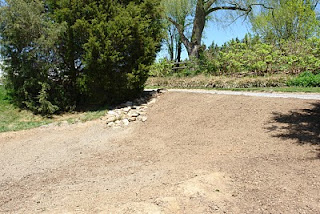When designing a rain garden there are several factors that need to be taken into consideration. The first of which is the surrounding site of your desired
rain garden location. You need to ask yourself:
- What is the distance between the proposed rain garden and the established non-permeable structures? (i.e. house/parking lot/road)
- How much runoff is generated by these areas?
- What is the soil consistency and how high is the infiltration rate?
In addition to these key factors proper plant selection is crucial. Using a strong mix of
native plants that will tolerate the extremes of both wet and dry conditions will increase success.
Our Landenberg farm acts as a living laboratory for customers, employees and garden guests. Every couple of years a new palette of plants are installed in order for us to study them in different settings. Even though the pre existing rain garden in Landenberg was successful, runoff from the surrounding gravel driveways posed an issue. To remedy this problem we came up with a double “micro” forebay system, which slows water velocity and increases
sedimentation before
stormwater runoff enters the basin of the rain garden.
The first step was to clear out all of the existing plants, till, and re-grade the area. With re-grading complete, our next step was to lay the concrete slabs that would serve as the base of the forebays (slabs allow for easy clean up of runoff sediment). Next, our ground cloth and filter socks were set into place (the addition of these will prevent erosion and the possible establishment of a mosquito pond). Stone slabs, from the neighboring quarry in Avondale, were then set into place to give the forebay a more natural look.
 |
| Step 1: Clear, till & re-grade |
 |
Step 2: Lay the concrete slabs that will
serve as the base of the forebays |
 |
| Step 3: Set ground cloth and filter socks into place |
 |
Local stone from the Avondale Quarry
give the forebays a more natural look |
The final step was installing a mix of native perennials and shrubs including:
Callirhoe involucrata,
Carex amphibola,
Carex pensylvanica,
Chelone glabra,
Clethra alnifolia,
Helenium 'Mardi Gras',
Itea virginica,
Ilex verticillata,
Iris cristata 'Powder Blue Giant',
Juncus effusus,
Liatris spicata,
Lobelia cardinalis,
Lobelia siphilitica,
Monarda 'Raspberry Wine',
Packera aurea, (syn. Senecio aureus),
Solidago rugosa 'Fireworks',
Spartina patens,
Symphyotrichum novae-angliae 'Bluebird' (syn.
Aster novae-angliae 'Bluebird'),
Vernonia glauca.
 |
| Helenium 'Mardi Gras' |
 |
| Monarda 'Raspberry Wine' |
 |
| Carex amphibola |
 |
| Solidago rugosa 'Fireworks' |
A week after installation we received 1 ¾ inches of rain in less than a half hour! On the bright side, the two “micro” forebays fulfilled their duty and all of the plugs remained intact. Ironically enough the only plants misplaced were the one gallon Chelone glabra. To this day, our rain garden re-designed has been performing above and beyond expectations. Never underestimate the strength of a plug…now only if the rain would return!
 |
| 'Micro' forebays hard at work |
 |
| Newly installed rain garden, May 2010 |
 |
| Rain garden, July 2010 |














Comments
Post a Comment